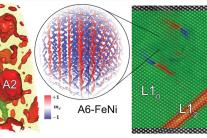Clandestine Exotic Metal Discovered in Meteorite
Mon, 09/27/2021 - 8:51amResearchers in the U.S. and Germany have found a new metallic phase of iron-nickel in a meteorite from North-West Africa (NWA6259). This metallic phase, previously undetected due to its very small size, exhibits exotic structural and magnetic properties, and these new findings extend and possibly alter our understanding of celestial metallurgy, provide new knowledge concerning the archetypal Fe−Ni phase diagram and supply new information for the development of new types of sustainable, technologically critical high-energy magnets.
Iron and its alloys have made modern civilization possible, with metallic meteorites providing one of the human’s earliest sources of usable iron as well as providing a window into our solar system’s billion-year history. From a materials science perspective, meteorites provide almost ideal environments for atomic arrangements to approach thermodynamic equilibrium during cooling over billions of years. Such conditions can permit the formation of tetrataenite, a tetragonal chemically ordered Fe-Ni phase with advanced engineering properties, which is extremely difficult to synthesize in macroscopic quantities suitable for technological applications. The team performed cutting-edge electron microscopy and atom-probe tomography experiments, as seen in the figure here, in combination with magnetometry experiments and simulations, and they found that the new nanophase exists alongside Ni-poor and Ni-rich nanoprecipitates within a matrix of tetrataenite. Importantly, this newly discovered phase is antiferromagnetic, i.e., it has zero net magnetization, and this suggests that previous experiments with meteoritic irons that have quantified the magnetic properties of tetrataenite did not consider that its measurable properties are in fact reduced due to the presence of this clandestine phase. New knowledge of the previously undescribed “hidden” structure and properties of the NWA 6259 meteorite impacts not only how iron meteoritic data might be used to interpret the origins of our solar system but also invites renewed consideration of tetrataenite as a sustainable permanent magnet for energy applications.
The study, led by Dr. Andras Kovacs from the Forschungszentrum Jülich in Germany and Dr. Michalis Charilaou from UL Lafayette Physics, will appear in the journal Nano Letters, published by the American Chemical Society. It is available online here: https://doi.org/10.1021/acs.nanolett.1c02573

